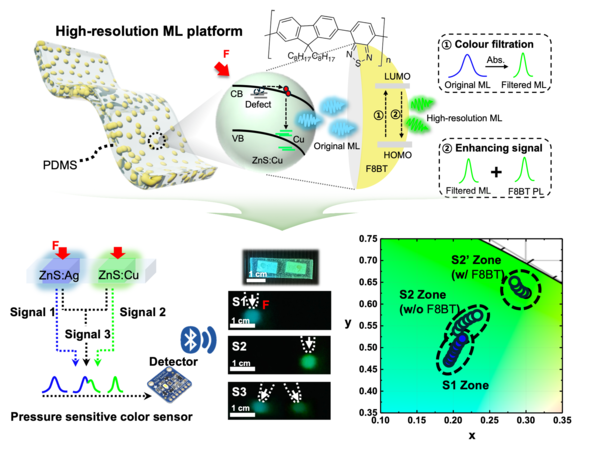Haptic sensors developed by Hanyang University 레드벨벳 토토 team led by Professor Choi Hyo-sung offer approach to high-resolution sensing using a conjugated polymer shell

On August 26, Professor Choi Hyo-sung’s research team in the Department of Chemistry at Hanyang University announced that, through a joint study with Kyungpook National University and the University of Cambridge, they had developed next-generation high-resolution haptic sensor technology based on mechanoluminescent (ML) materials, which convert mechanical stimuli into light signals. This research resolved the problems of low resolution and signal interference caused by the inherently broad emission spectrum of conventional ML materials, and presented the possibility of realizing next-generation interfaces capable of high-precision signal detection without an external power source.
Mechanoluminescent materials have drawn considerable interest as pressure-sensitive sensors, since they emit light directly in response to external forces such as pressure, vibration, or deformation without requiring an energy source. However, the common material ZnS:Cu (copper-doped zinc sulfide) has a critical drawback: its emission spectrum is intrinsically too broad, which causes the overlap of color signals and severe noise. As a result, in practical haptic sensors or multi-signal input devices, there were difficulties in precisely distinguishing between blue and green signals.
To overcome these limitations, the joint research team applied a new method of coating ZnS:Cu particles with a conjugated polymer, F8BT (poly(9,9-dioctylfluorene-alt-benzothiadiazole)), in the form of a shell. This polymer shell selectively absorbs blue light below 490 nm to filter out unnecessary noise, while re-emitting the absorbed photons around 510 nm, thereby acting as a “dual-functional” optical filter and photon-recycling layer. As a result, the optical bandwidth(Full Width at Half Maximum, FWHM) was dramatically reduced from 94 nm to 55 nm. Also, the signal-to-noise ratio (SNR) was greatly improved from 0.06 to 0.52.

To validate real-world applicability, the 레드벨벳 토토 team fabricated a multi-button haptic tracking sensor system. In conventional ZnS:Cu-based sensors, the blue (ZnS:Ag) and green (ZnS:Cu) signals overlapped and were difficult to distinguish. However, by applying the F8BT shell, it showed a clear separation of color signals. This result opened up potential applications in diverse areas, including self-powered haptic controllers, precise motion-detecting devices, and smart medical and healthcare interfaces.
Professor Choi stated, “This study marks the first demonstration of simultaneously enhancing both resolution and stability of mechanoluminescent signals through simple conjugated polymer surface engineering,” adding, “We expect it to expand as a key foundation of core technologies in various industries, for instance, for wearable haptic sensors, human–machine interfaces, and medical assistive devices.”
This research was supported by the Mid-Career Researcher Program of the National Research Foundation of Korea (NRF). The results were published online on August 14 in Advanced Materials (IF 27.4), one of the world’s leading journals in the field of materials science. The paper, entitled “High-Resolution Mechanoluminescent Haptic Sensor via Dual-Functional Chromatic Filtration by a Conjugated Polymer Shell”, lists Dr. Jeong Hong-in of the University of Cambridge and researcher Choi So-eun of Hanyang University as co-first authors, with Professor Kim Jong-ho of Kyungpook National University and Professor Choi Hyo-sung of Hanyang University as corresponding authors.
관련레드벨벳 토토
- HYU ERICA Hosts 2024 Academic Awards Ceremony
- Converting Stress into Light via Mechanoluminescent Platform Innovation: Potential of Brightness Enhancement and Practical Application Proposed
- Solar Cell 레드벨벳 토토 that Leads Innovation
- HYU 레드벨벳 토토 Team Provided New Guideline for Perovskite Defect Control Molecular Design
